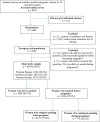Characteristics of women who continue smoking during pregnancy: a cross-sectional study of pregnant women and new mothers in 15 European countries
- PMID: 24964728
- PMCID: PMC4080751
- DOI: 10.1186/1471-2393-14-213
Characteristics of women who continue smoking during pregnancy: a cross-sectional study of pregnant women and new mothers in 15 European countries
Abstract
Background: Some women continue smoking during pregnancy despite the extensive information available on the dangers smoking poses to their fetus. This study aimed to examine the prevalence and determinants of smoking before and during pregnancy and the extent of smoking during pregnancy from a European perspective in relation to maternal sociodemographic characteristics, health literacy, morbidity, and pregnancy-related factors.
Methods: This multinational, web-based study evaluated pregnant women and new mothers in 15 European countries recruited from October 2011 to February 2012. Data were collected via an anonymous online questionnaire.
Results: Of 8344 women included, 2944 (35.3%) reported smoking before pregnancy, and 771 (26.2%) continued smoking during pregnancy, 88 (11.4%) of whom smoked more than 10 cigarettes per day. There was a wide variation among the 15 European countries in smoking rates before and during pregnancy, ranging from 25.0% (Sweden) to 50.0% (Croatia) before and 4.2% (Iceland) to 18.9% (Croatia) during pregnancy. Women who lived in Eastern Europe, without a spouse/partner, with a low education level and unplanned pregnancy, who did not take folic acid, and consumed alcohol during pregnancy were the most likely to smoke before pregnancy. Women who lived in Eastern or Western Europe, without a spouse/partner, with a low education level and health literacy, being a housewife, having previous children and unplanned pregnancy, and who did not take folic acid were the most likely to continue smoking during pregnancy. Women who smoked more than 10 cigarettes per day during pregnancy were the most likely to be living in Eastern Europe and to have a low education level.
Conclusion: Women with fewer resources living in Western or Eastern Europe are more likely not only to smoke before pregnancy but also to continue smoking during pregnancy. These high-risk women are characterized as living alone, having high school or less as highest education level, having low health literacy, being a housewife, having previous children, having unplanned pregnancy, and no use of folic acid. Our findings indicated that focus on smoking cessation is important in antenatal care in Europe as many women smoke before pregnancy, and still continue to do so in pregnancy.
Figures
References
-
- World Health Organization. WHO Report on the Global Tobacco Epidemic, 2009: Implementing Smoke-Free Environments. Geneva, Switzerland: World Health Organization; 2009.
Publication types
MeSH terms
Substances
LinkOut - more resources
Full Text Sources
Other Literature Sources



